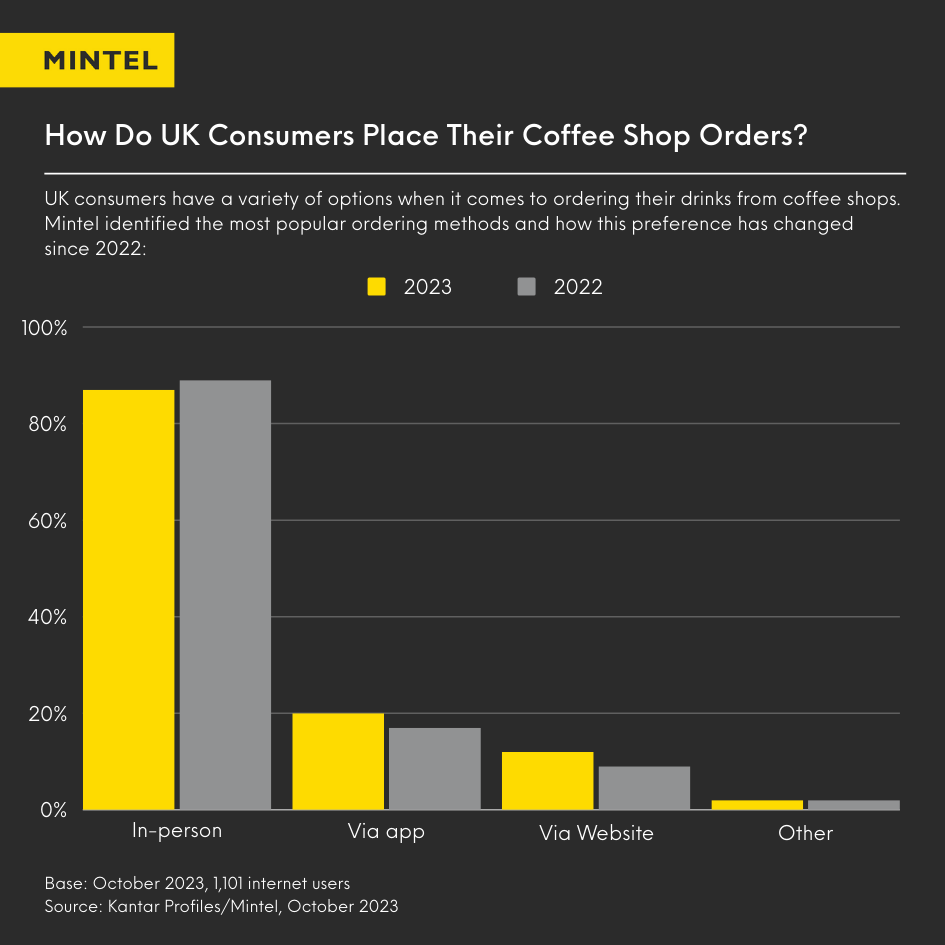In times of inflationary pressure, consumers’ might turn their backs on coffee shops and opt for both value and premium formats. A rise in usage of instant coffee and mixes provide money-saving value options for consumers, but are posing a threat to coffee shops, as people visit them less often to save money.
How can coffee brands unlock the worth of espresso in the face of changing consumer behaviour and what can coffee shops do to remain relevant? Read on to find out.
How is the Coffee Market Changing?
With rising inflation and strained budgets, people are looking to get the coffee shop experience at home with value formats and certain blends that replicate barista coffee. Instant coffee and mixes are the perfect answer for coffee lovers on a bargain hunt with instant coffee dominating the UK coffee market. In the short term, continuing pressures on household incomes hold further potential for lower cost formats, and brands can tap into the disruptions to shoppers’ habits. Especially younger consumer groups can be engaged through coffee shop style drinks at home.
Instant coffee is also having a moment in the US. 1 in 4 US coffee consumers rate ease of preparation as the most important factor for at-home coffees. Therefore, instant coffee’s winning combination of value and convenience makes it at-home coffee drinkers’ go-to choice, and contributed to a 7% increase in instant coffee retail sales in 2023.
While this is good news for coffee brands, this raises red flags for coffee shops. The coffee shop industry has already undergone immense pressure during the pandemic while it was subjected to constant closures. Now, coffee shops are, again, feeling the heat of the rising food and drink prices, 80% of Irish consumers now prefer to make hot drinks at home or work as a direct result of the cost-of-living crisis. Furthermore, the coffee shop industry is being threatened by non-specialists, as now over half of German consumers buy drinks from bakeries and in-store outlets rather than coffee shops.
To appeal to their customers during an economic downturn, coffee shops must emphasise their unique attributes, such as barista-made drinks, the social and indulgence aspects associated with enjoying a cup of coffee at a café while reading a book, or chatting with friends.
Coffee Market Trends – Look Familiar?
Coffee consumer trends show that, while brand familiarity was a strong purchase driver in 2023, seeing almost three-quarters of Canadian coffee drinkers are consuming the same coffee everyday, the continued income squeeze has prompted widespread trading down with low brand loyalty in a competitive and fragmented market. A significant number of UK consumers now prioritise price over brand when choosing a coffee shop.
Established brands have been hit hard; although Nescafé retains its lead in the instant coffee segments in the UK and the US, the market leader was not immune to trading down. Meanwhile private labels stand out as the star performer in the category, gaining five percentage points of UK market share since 2022.
The Caffeine Reduction Trend
An increased awareness of health, including concerns over the impact of caffeine on sleep and mood causes a substantial threat to coffee shops and the coffee market. The caffeine reduction trend causes 2 in 5 UK consumers to cut down their caffeine intake.
The rising demand for low- and no-caffeine variants also present an opportunity to expand consumers’ coffee drinking occasions beyond the usual morning cup. Brands in the coffee market are already taking advantage of the caffeine reduction trend. Mintel’s Global New Products Database (GNPD) data shows a 30% increase in product launches for caffeine-free coffee products between 2022 and 2023.
However, consumers’ caffeine concerns are nuanced. Most coffee drinkers prefer to cut down on their coffee intake rather than switch to decaffeinated options, as decaf options fail to win over most concerned consumers. But, over half of UK coffee drinkers show interest in information about caffeine levels and products offering varied levels of it. Despite this consumer demand, only a few UK coffee brands call out their caffeine level, and if they do, the focus is largely on high caffeine levels. Coffee brands in other markets have already successfully launched products with half caffeine levels, to offer the appropriate buzz depending on the time of day.
Why People Will Remain Both the Ultimate Challenge and Answer for Sustainable Coffee
The pressure on household incomes has seen green issues take a backseat, but Mintel predicts a longer-term uplift in interest. Although sustainability concerns are gaining traction, and environmental initiatives draw consumer interest, the majority of coffee drinkers are not willing to try lab-grown coffee.
The main purchase drivers for coffee remain taste and indulgence. Therefore, it is not surprising that consumers hold reservations towards sustainable coffee innovation, such as lab-grown coffee. The goal for coffee brands is to combine both taste and indulgence with sustainable practices. Investments in solutions that benefit the Earth and consumers alike, e.g. climate resilient beans, will be key in aligning consumer demand with planetary health. For example, Nescafé, who are considered a trusted brand by consumers, have dedicated an entire part of their website to sustainable coffee, communicating to their consumers what sustainable sourcing means and how their coffee is farmed.

Nescafé dedicates part of their website to communicate the farming and production of their coffee transparently. Source: sustainability.nespresso.com
Why reusable cups provide opportunities for sustainability without compromising on taste: Despite consumer awareness around plastic pollution, convenience is still at the top of people’s minds, thus maintaining the popularity of takeaway coffee. Bring-your-own-cup schemes are not gaining enough traction, as always having your own cup on hand is not viewed as convenient.
The German government introduced a Reusable Packaging Law, which obliges venues selling takeaway food and drinks to offer their products in reusable containers as an alternative to disposables. Yet, 40% of Germans who buy drinks-to-go from coffee shops do not typically opt for reusable cups, leaving scope for coffee shops to do more to encourage sustainable behaviours and cut waste. Coffee shop operators can improve visibility of reusable options and how to return them, for example, by incorporating reusables into sales processes via prompts at point of purchase such as making reusables the default option.
How are Customers Buying, Ordering, and Consuming Coffee?
Ice, Ice Baby
Iced beverages are picking up on coffee shop menus as consumers opt to go cold over hot more than ever before. Gen Z and Millennials are driving this trend as they seek beverages that deliver on taste and aesthetics. However, Gen Zs’ love for iced coffee has been impacted by rising prices. For a more affordable option, coffee brands can offer instant iced options inspired by foodservice. Major brands are already mobilising in this space. In April 2024, Nescafé announced they would be launching Ice Roast in the US, which the brand described as their first soluble coffee designed specifically to be mixed with cold water.
Customisation and personalisation are key attractions for younger consumers, who enjoy visually appealing iced coffee presentations that are suitable for social media sharing. Social media, especially platforms like TikTok, plays a significant role in influencing iced coffee trends. Brands are leveraging consumers’ urge to share on social media by offering products that allow for customisation and indulgence, such as unique toppings and flavour mixes.
Sitting In vs. Taking Away
After years of on and off coffee shop closures due to the pandemic, in-store participation is back on track as social coffee drinking occasions outside the home are picking up again along with spontaneous stops at coffee shops on the way to work.
Despite having access to a greater range of takeaway options, the latest coffee consumption trends suggest that in-store purchases remain the most popular and preferred coffee drinking method in the UK, and a similar trend has been observed in China.
In the post-pandemic years, coffee shops have emerged as a viable ‘third place’, a social environment separate from the home ‘first place’ or workplace ‘second place’. In Canada, a notable percentage of visitors use coffee shops as supplements to office or home workspaces. Similarly in China, coffee shops serve as an important third space for socialising, especially among young consumers who seek novel experiences and social activities.
Coffee Shop Market Trends: Ordering Coffee Using Apps
The latest consumer research shows that one-fifth of UK consumers use coffee shop apps to place their orders. Alternative order methods are gaining traction, particularly among younger consumers. Operators, especially chains, are fuelling this coffee shop trend by seamlessly integrating online and in-store experiences. For example, in the UK Costa Coffee encourages app usage by showing how easy it is for users to locate nearby outlets, pre-order drinks, and earn loyalty points by using the app.

How is the Revenue of the Coffee Shop Industry Being Impacted by Recent Behaviour and Purchase Trends?
The current economic climate and consumers’ financial situation influences coffee trends and usage. Usage of ground coffee and coffee pods, particularly, has dropped among those who are financially struggling, echoing the higher price of these products while demonstrating that coffee shops risk losing customers during the cost of living crisis.
Nevertheless, increased engagement with coffee mixes and RTD coffee show that 37% of UK consumers still need their daily dose of energy in the form of caffeine, but are seeking it at a lower price point. The rise in usage of coffee mixes as well as the increased engagement with RTD coffee is driving booming sales in this segment, creating more competition in the coffee (shop) market.
This rise in mixes and RTD coffee threatens coffee shop industry growth, and operators will have to redefine their value for money and defend their position and products, by emphasising the coffee shop experience of coffee consumption.
How is the Coffee Market Changing? 2024 Trends in Coffee and How Your Business Can Tap into Them
1. Compete with non-specialists and cheaper alternatives.
Private label’s newly competitive quality perceptions are setting the standard during the cost-of-living crisis, and brands will have to follow their lead. Although coffee shops remain popular, they also face competition from cheaper, non-specialist alternatives, such as retail cafés.

For instance, McDonald’s McCafé, offers a free hot drink with the purchase of a breakfast through its app-exclusive deals. Source: McDonald’s UK
Similarly, coffee shops see themselves threatened by cheaper at-home coffee options that promise a barista coffee experience. To remain relevant in a highly competitive landscape, operators can offer tiered pricing models, ranging from standard to premium blends.
2. Position your brand to appeal to caffeine-conscious consumers.
Consumers are worried about the effects of caffeine on their health, particularly their mental wellbeing and sleep heath. To appeal to those seeking to reduce their caffeine intake, brands and operators should communicate the contents of their drinks more transparently, while also offering options that feel personalised to consumers’ desired ‘buzz’.
3. Support social enterprises.
More than half of consumers agree that social enterprise coffee shops help to create a stronger sense of community. Operators have an opportunity to capitalise on people’s desire to support brands that advocate for social causes while also empowering underrepresented consumer groups.
Despite the desire to support a good cause with their purchase, consumers remain cautious when it comes to sustainable coffee innovations. To foster growth, beanless brands will have to communicate taste over sustainability, as taste and indulgence remain the most prominent purchase factors for three-fifths of coffee drinkers in the UK.
4. Provide amenities for furry customers.
With 50% of UK consumers finding dog-friendly venues appealing, this trend highlights the growing demand for pet-inclusive spaces that cater to the needs of both humans and their furry companions.
Is your business ready for the next five years? Don’t just react to market shifts, anticipate them. From in-depth consumer reports revealing evolving attitudes to bespoke growth strategies tailored to your unique needs, we’ve got you covered. Dive into The Future of Coffee to unlock crucial insights on global trends anticipated over the next five years, or explore A Year of Innovation in Coffee to discover the breakthrough products shaping the industry.
For those interested in the carbonated drinks market and want to understand the drivers behind the anticipated sustained growth over the coming years, read our US-focused Carbonated Soft Drinks Market Report.
Want to stay ahead of your competitors? Explore our comprehensive Drinks Market Research or Subscribe to Spotlight and get exclusive, analyst-driven insights delivered straight to your inbox!



































